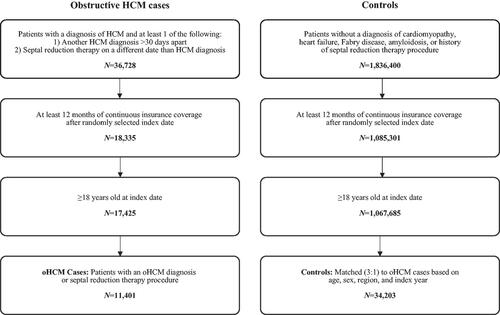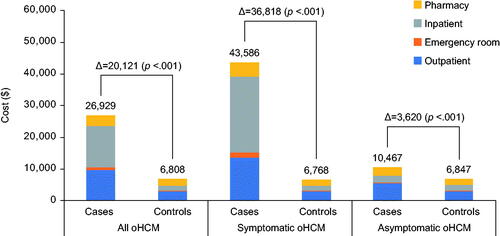Figures & data
Figure 1. Study design and sample selection. The study population was drawn from the US IBM MarketScan Commercial and Medicare Supplemental Database from January 2009 to March 2019. Patients with HCM were identified based on a diagnostic code for HCM and confirmation by either a second HCM diagnostic code more than 30 days apart or a claim for septal reduction therapy on a separate date from the initial HCM diagnosis along with a randomly-selected index date after diagnostic confirmation. After excluding patients aged <18 years, those who did not have ≥12 months of continuous coverage after the index date, and those who did not have a diagnostic code for obstructive HCM, the analytic cohort comprised 11,401 patients with obstructive HCM. Potential controls without HCM were selected if they did not have a diagnosis of cardiomyopathy, heart failure, Fabry disease, amyloidosis, or a history of a septal reduction therapy procedure, and assigned a randomly selected index date. After excluding those without continuous insurance coverage for 12 months after the index date, control patients were matched to each oHCM patient in a 3:1 fashion based on age, sex, geographic region, and index year. Abbreviations. HCM, hypertrophic cardiomyopathy; oHCM, obstructive hypertrophic cardiomyopathy.

Table 1. Patient characteristics.
Table 2. Healthcare resource utilization and cost—overall oHCM population.
Figure 2. Mean 1-year healthcare cost for oHCM, symptomatic oHCM, and asymptomatic oHCM versus matched controls. Total annual costs and the estimated difference in costs between oHCM patients and matched controls are shown along with subgroup analyses for patients with symptomatic oHCM and asymptomatic oHCM. Total annual cost/patient includes inpatient, emergency department, outpatient, and pharmacy costs. Abbreviation. oHCM, obstructive hypertrophic cardiomyopathy.

Table 3. Healthcare resource utilization and cost—symptomatic oHCM population.
Supplemental Material
Download MS Word (52.6 KB)Data availability statement
The datasets generated during and analysed for the current study are not publicly available as they were used under license from IBM Watson Health.
